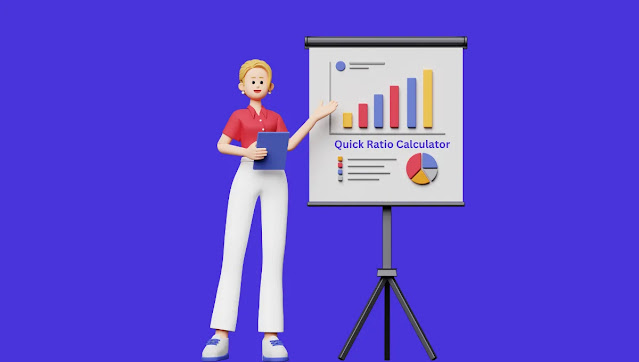Just type in the quick assets, which are things like cash and stuff that can turn into money quickly, and the current liabilities, which are things the company needs to pay within a year.
A quick click will tell you if the company has enough quick assets to cover its short-term bills, making financial decisions a breeze.
In today's complex financial world, understanding and managing your financial health is crucial.
One key aspect of this is the quick ratio, which measures a company's ability to meet short-term obligations with its quick assets.
Utilizing a quick ratio calculator can provide instant insights into your financial stability and aid in making informed decisions.
Let's delve into the quick ratio, its calculation, and its significance in maintaining a healthy financial profile.
What is the Quick Ratio and How Does it Impact Your Financial Health?
Understanding the Quick Ratio
The quick ratio, also known as the acid test ratio, is a financial metric that measures a company's short-term liquidity.
It considers the most liquid assets, such as cash and cash equivalents, marketable securities, and accounts receivable, and compares them to current liabilities.
Importance of Quick Ratio in Financial Health
The quick ratio is essential in evaluating a company's ability to pay off its immediate obligations without the need to sell inventory or obtain additional financing.
It provides insight into the company's short-term financial strength and liquidity position.
Factors Affecting Quick Ratio
Several factors can impact the quick ratio, including the composition of a company's current assets, the promptness of receivables collections, and the structure of short-term liabilities, such as accounts payable and short-term debt.
How to Calculate the Quick Ratio Using a Calculator?
Step-by-Step Guide to Using a Quick Ratio Calculator
To calculate the quick ratio, use the formula: Quick Ratio = (Total Current Assets - Inventory - Prepaid Expenses) / Total Current Liabilities.
A quick ratio calculator simplifies this process, enabling you to input the required values and obtain the quick ratio instantly.
Interpreting the Results from Quick Ratio Calculator
Once you have the quick ratio value, it's crucial to interpret it within the context of your financial health.
A ratio higher than 1 indicates that a company has enough quick assets to cover its current liabilities, while a ratio lower than 1 may signify potential liquidity issues.
Using the Quick Ratio Calculator for Financial Planning
By using a quick ratio calculator, you can proactively assess your financial position, identify areas of improvement, and make informed decisions for better financial planning and management.
Comparing Quick Ratio to Other Financial Ratios
Quick Ratio vs. Current Ratio: What's the Difference?
While the quick ratio focuses on the most liquid assets, the current ratio considers all current assets.
This means that the current ratio may include inventory and prepaid expenses, making the quick ratio a more conservative measure of a company's liquidity position.
Understanding Acid Test Ratio and Its Relationship to Quick Ratio
The acid test ratio is synonymous with the quick ratio, both representing the ability to meet short-term liabilities using the most liquid assets.
Therefore, these ratios are parallel in significance for assessing short-term liquidity.
Interpreting Quick Ratio in the Context of Overall Liquidity Ratios
When evaluating a company's financial health, it's important to analyze multiple liquidity ratios.
It includes the current ratio and the cash ratio, to gain a comprehensive understanding of its liquidity position and short-term solvency.
Why is a Good Quick Ratio Essential for Financial Stability?
Impact of Quick Ratio on Liquidity and Solvency
A strong quick ratio indicates robust liquidity and suggests that a company can easily meet its short-term obligations without relying on inventory or long-term financing.
This enhances the company's overall solvency and financial stability.
How Quick Ratio Influences Investment and Lending Decisions
Investors and lenders often consider the quick ratio as a key indicator of a company's financial health.
A healthy quick ratio instills confidence in potential investors and creditors, showcasing the company's ability to manage its short-term obligations effectively.
Strategies to Improve Quick Ratio and Enhance Financial Health
To bolster the quick ratio, companies can focus on optimizing working capital management, improving receivables collections, and negotiating favorable payment terms with suppliers.
These strategies can contribute to a stronger quick ratio and overall financial health.
Utilizing Quick Ratio Calculators for Instant Financial Insights
Benefits of Using Quick Ratio Calculators
Quick ratio calculators offer the advantage of swift and accurate calculations, empowering individuals and businesses to assess their financial standing promptly.
They provide a convenient tool for monitoring and managing short-term liquidity.
Common Mistakes to Avoid When Using Quick Ratio Calculators
When using quick ratio calculators, it's important to input the correct values for total current assets and liabilities to ensure accurate results.
Additionally, overlooking certain quick assets could lead to misleading interpretations of the calculated ratio.
Guidelines for Selecting the Best Quick Ratio Calculator
When choosing a quick ratio calculator, consider one that offers clear instructions, a user-friendly interface, and the ability to handle complex calculations.
Seeking recommendations and reading reviews can help identify a reliable quick ratio calculator.



.png)

.png)
.png)
.png)
.png)

.png)
_11zon.webp)


0 Comments